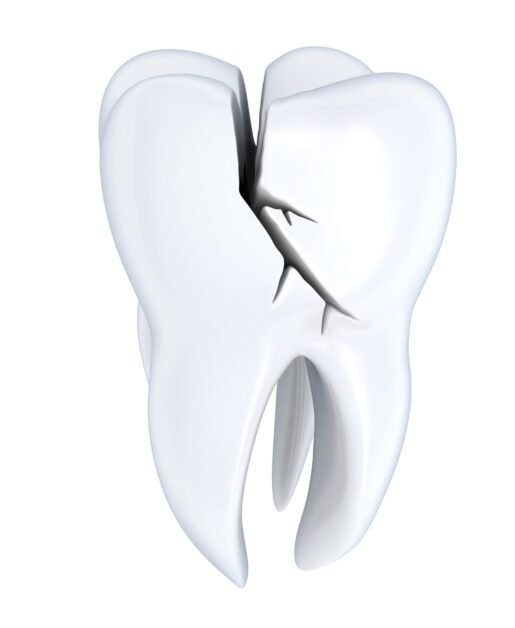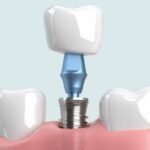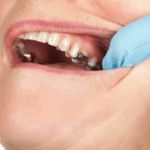Table of Contents
Causes of a Cracked Tooth
Cracked teeth can occur due to a variety of reasons, and it’s important to understand the causes to prevent further damage. One common cause is dental trauma, which can happen from accidents, sports injuries, or even from biting down on hard objects. The force applied to the tooth can result in a crack, ranging from a small fracture to a more severe split.
Another cause of cracked teeth is tooth decay. When cavities are left untreated, they can weaken the structure of the tooth, making it more susceptible to cracks. Additionally, large fillings or dental restorations can compromise the tooth’s integrity and lead to cracking over time. The pressure from chewing and grinding can also contribute to cracked teeth, especially if there are bite alignment issues or excessive force applied during these actions.
It’s worth noting that age and overall dental health can also play a role in the likelihood of experiencing a cracked tooth. As we age, our teeth naturally become more brittle and prone to cracks. Bruxism, or teeth grinding, can also put excessive pressure on the teeth and increase the risk of cracks. Understanding these causes can help individuals take preventive measures and seek appropriate dental care to minimize the risk of a cracked tooth.
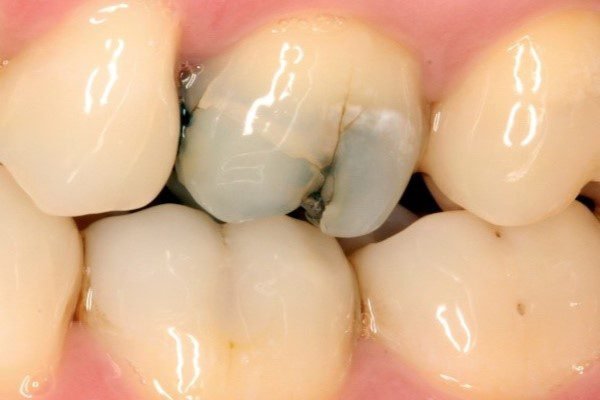
Signs and Symptoms of a Cracked Tooth
A cracked tooth can cause a range of signs and symptoms, which can vary depending on the extent and location of the crack. Some common signs of a cracked tooth include sudden pain during chewing or biting, sensitivity to hot or cold temperatures, and discomfort when releasing the bite pressure. In some cases, a crack in the tooth may not be visible to the naked eye, making it difficult to diagnose without the assistance of a dental professional. Consequently, it is crucial to pay attention to any unexpected changes or discomfort in your teeth and seek professional dental care if you suspect a cracked tooth.
In addition to pain and sensitivity, a cracked tooth may also cause other symptoms such as intermittent or persistent toothache, swelling of the gum around the affected tooth, difficulty in chewing or biting, and even a change in the appearance or color of the tooth. These symptoms can vary in intensity and duration, depending on the severity of the crack and any underlying dental conditions. It is important to note that some cracked teeth may not cause any noticeable symptoms initially, but they can still pose a risk of further damage if left untreated. Regular dental check-ups and early detection are key in preventing complications and preserving the health of your teeth.
Types of Cracked Teeth
Cracked teeth can occur in various ways, each presenting different challenges and treatment options. One common type of cracked tooth is a craze line, which is a small crack that only affects the outer enamel of the tooth. While craze lines are generally harmless and don’t require treatment, they may be a cosmetic concern for some individuals.
Another type of cracked tooth is a fractured cusp, which involves the breaking of a small piece of the tooth’s chewing surface. Fractured cusps often occur when a dental filling is large and weakens the tooth’s structure. While these cracks rarely cause pain, they can lead to sensitivity or the trapping of food debris between the teeth.
A more severe type of cracked tooth is a split tooth, which occurs when a cracked tooth is left untreated. As the crack deepens, the tooth splits into separate segments, potentially causing pain and discomfort. Depending on the severity of the split, treatment options may include root canal therapy or, in more extreme cases, tooth extraction.
It is important to note that these are just a few examples of the types of cracked teeth that individuals may experience. Each case is unique, and it is crucial to consult with a dental professional for an accurate diagnosis and appropriate treatment plan.
| Type of Cracked Tooth | Description |
|---|---|
| Craze Lines | Superficial cracks on the enamel surface; often harmless and do not require treatment. |
| Fractured Cusp | A portion of the tooth’s chewing surface breaks off, usually as a result of trauma or decay. |
| Cracked Tooth | A crack extends from the chewing surface towards the root; may cause discomfort or sensitivity. |
| Split Tooth | A crack extends through the tooth, dividing it into distinct segments; may require extraction. |
| Vertical Root Fracture | A crack that starts from the root towards the chewing surface; often requires root canal therapy. |
Risk Factors for Cracking a Tooth
Cracking a tooth can be a painful experience, and there are certain risk factors that can increase the likelihood of this happening. One of the major risk factors is engaging in activities that put excessive pressure on the teeth. For example, biting down on hard objects such as ice, hard candies, or pens can lead to cracks in the tooth enamel. Similarly, grinding or clenching the teeth, also known as bruxism, can weaken the teeth and make them more susceptible to cracking.
Another risk factor for tooth cracking is having large fillings or restorations. When a tooth has undergone extensive dental work, such as a large filling or crown, it becomes weaker and more prone to fractures. Additionally, teeth that have undergone root canal treatment are also more susceptible to cracks due to the removal of the dental pulp, which can cause the tooth to become brittle over time.
Diagnosing a Cracked Tooth
When it comes to diagnosing a cracked tooth, it can be a challenging task for dentists. This is because cracked teeth can present with a wide range of symptoms, or no symptoms at all. Often, patients may only experience intermittent pain when biting or chewing, making it difficult to pinpoint the exact cause. Additionally, the location and severity of the crack can vary, further adding to the complexity of the diagnosis.
To diagnose a cracked tooth, dentists will typically begin with a thorough examination of the patient’s oral cavity. They will carefully inspect the teeth visually and may also use dental instruments to assess the tooth’s structure and integrity. In some cases, dental X-rays or other imaging techniques may be necessary to reveal hidden cracks or fractures that are not visible to the naked eye. Dentists will also take into consideration the patient’s medical history and any reported symptoms to form a comprehensive diagnosis.
It is important to note that a cracked tooth may go undetected during a routine dental check-up. Some cracks are so small or difficult to detect that they may not be visible on X-rays or even during a comprehensive examination. In these cases, the crack may only be identified when symptoms worsen or complications arise. Therefore, if you suspect that you may have a cracked tooth, it is crucial to consult a dentist for a thorough evaluation and appropriate treatment options.
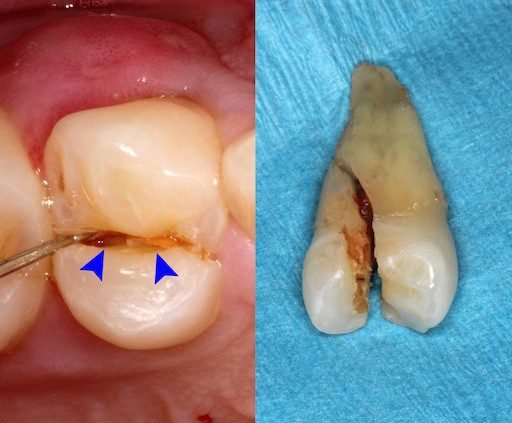
Importance of Seeking Dental Care for a Cracked Tooth
A cracked tooth may seem like a minor issue at first, but it is crucial to seek dental care as soon as possible. Ignoring a cracked tooth can lead to more severe dental problems down the line. By seeking prompt dental care, you can ensure that the issue is addressed effectively and prevent further damage to your tooth and oral health.
One of the main reasons why seeking dental care for a cracked tooth is important is the potential for infection. When a tooth is cracked, it creates an opening through which bacteria can enter and cause an infection. This can lead to pain, swelling, and even the spread of infection to other parts of the mouth or body. By seeking dental care, your dentist can assess the extent of the crack and determine the most appropriate treatment to prevent infection and protect your overall health.
Furthermore, dental care for a cracked tooth is essential to preserve the tooth structure and function. Even a small crack can compromise the strength and stability of the tooth. Without proper treatment, the crack can worsen over time, making it more difficult to save the tooth. Seeking dental care early on allows your dentist to evaluate the severity of the crack and recommend suitable treatment options to restore the tooth’s integrity and functionality. Remember, saving your natural tooth is always preferred over extraction, as it helps maintain proper oral function and prevents further complications.
Non-Surgical Treatment Options for a Cracked Tooth
There are several non-surgical treatment options available for individuals with a cracked tooth. The choice of treatment depends on the severity and extent of the crack, as well as the specific needs of the patient. One option is bonding, where a tooth-colored resin material is applied to the cracked tooth and then hardened with a special light. This helps to restore the tooth’s appearance and function, providing a protective barrier for the crack. Bonding is a conservative treatment option that can be completed in a single dental visit, making it a convenient choice for many patients.
Another non-surgical treatment option for a cracked tooth is the use of dental veneers. These are thin shells made of porcelain or composite resin that are custom-made to fit over the front surface of the tooth. Veneers can effectively hide cracks and improve the overall appearance of the tooth. They are a great option for individuals who have cracked front teeth and are looking for an aesthetic solution. In some cases, dental crowns may be recommended for treating a cracked tooth. A crown is a tooth-shaped cap that is placed over the damaged tooth to provide stability and protection. Crowns can restore both the function and appearance of a cracked tooth, and they are particularly beneficial for cases where the crack extends below the gum line or involves a large portion of the tooth. To determine the most appropriate non-surgical treatment option for a cracked tooth, it is important to consult with a qualified dentist who can assess the individual situation and provide personalized recommendations.
| Treatment Option | Description |
|---|---|
| Dental Bonding | Composite resin is applied to the cracked tooth and shaped to restore its appearance and function. |
| Dental Crown | A dental crown covers the cracked tooth entirely, providing protection and stability. Crowns can be made from various materials like porcelain, metal, or a combination of both. |
| Dental Veneers | Thin shells of porcelain or composite resin are bonded to the front surface of the cracked tooth to improve its appearance and strength. |
| Tooth-Colored Fillings | Composite resin fillings are used to fill in small cracks and restore the tooth’s structure and function. |
| Root Canal Therapy | If the crack extends into the pulp chamber of the tooth, root canal therapy may be necessary to remove damaged tissue and seal the tooth’s interior. |
Bonding as a Solution for a Cracked Tooth
Bonding is a common and effective solution for a cracked tooth. It is a dental procedure in which a tooth-colored resin material is applied to the cracked tooth surface, molded into shape, and then hardened with a special light. This process not only repairs the crack, but also restores the tooth’s strength and natural appearance.
One of the major advantages of bonding is its simplicity and cost-effectiveness compared to other treatment options. The procedure can often be completed in a single visit to the dentist’s office, saving both time and money. Additionally, bonding is a conservative approach that requires minimal or no alteration of the natural tooth structure, making it a less invasive option for cracked tooth repair. However, it is important to note that bonding may not be suitable for larger or more severe cracks, as it may not provide the necessary durability and longevity for those cases.
Dental Veneers to Fix a Cracked Tooth
Dental veneers are a popular and effective treatment option for fixing a cracked tooth. These thin, custom-made shells are designed to cover the front surface of the tooth, providing a natural and aesthetically pleasing appearance. The veneers are bonded to the tooth using a strong dental adhesive, which ensures long-lasting results.
One of the major advantages of dental veneers for cracked teeth is their ability to restore both the function and appearance of the tooth. By covering the cracked tooth, veneers can prevent further damage and provide support to the weakened tooth structure. They can also enhance the symmetry of the smile and improve the overall alignment of the teeth.
Furthermore, dental veneers are highly resistant to staining, making them a durable and reliable option for cracked teeth. With proper care and maintenance, veneers can last for many years, providing patients with a long-term solution for their cracked tooth. It is important to note, however, that not all cracked teeth are suitable for veneers. A thorough evaluation by a dentist is necessary to determine if veneers are the appropriate treatment option for your specific case.
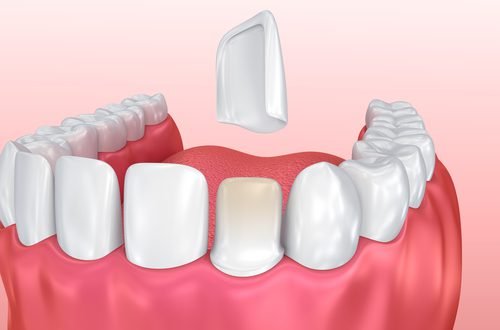
Dental Crowns for Treating a Cracked Tooth
Dental crowns are a commonly used treatment option for cracked teeth. A dental crown, also known as a cap, is a custom-made restoration that covers the entire tooth. It is designed to protect the cracked tooth from further damage and restore its strength and functionality.
The process of getting a dental crown typically involves two visits to the dentist. During the first visit, the dentist will prepare the cracked tooth by removing any damaged or decayed tissue. They will then take impressions of the tooth, which will be used to create a custom crown in a dental laboratory. In the meantime, a temporary crown will be placed to protect the tooth.
Once the custom crown is ready, the patient will return for their second visit. The temporary crown will be removed, and the permanent crown will be carefully fitted and bonded to the cracked tooth. Dental crowns are made from durable materials such as porcelain, metal, or a combination of both, providing long-lasting protection and aesthetics. Additionally, with proper care and regular dental check-ups, a dental crown can help preserve a cracked tooth for many years to come.
Root Canal Therapy for a Cracked Tooth
Root canal therapy, also known as endodontic treatment, is a common dental procedure used to treat a cracked tooth. When a tooth is cracked, the sensitive inner tissues, known as the dental pulp, can become exposed and vulnerable to infection. Root canal therapy aims to remove the infected pulp, clean the root canal, and seal it to prevent further infection.
During a root canal procedure, the dentist starts by numbing the affected tooth and surrounding area to ensure the patient’s comfort. Then, a small hole is created in the tooth to access the pulp chamber and root canals. The infected pulp is carefully removed, and the canals are cleaned and shaped. Once the canals are thoroughly disinfected, they are filled with a biocompatible material known as gutta-percha, which seals off the canals and prevents bacteria from reentering. Finally, a dental crown or filling is placed on the tooth to restore its strength and protect it from further damage.
Root canal therapy is a highly effective treatment for cracked teeth, as it not only helps alleviate pain and discomfort but also preserves the natural tooth structure. By getting timely root canal treatment, patients can avoid the need for tooth extraction and maintain a healthy smile. However, it is important to remember that not all cracked teeth require root canal therapy. A thorough examination and diagnosis by a skilled dentist is necessary to determine the most appropriate treatment option for each individual case.
Tooth Extraction as a Last Resort for a Cracked Tooth
Tooth extraction is considered as a last resort when it comes to treating a cracked tooth. This procedure involves the removal of the damaged tooth from its socket in the jawbone. While dentists strive to save natural teeth whenever possible, there are certain situations where tooth extraction becomes necessary.
One of the main reasons for tooth extraction as a last resort is when the crack in the tooth extends deep into the root. In such cases, the crack may cause severe pain and discomfort, and it becomes difficult for the tooth to be restored through other treatment options. Additionally, if the cracked tooth is severely infected and cannot be effectively treated with root canal therapy, extraction may be the best course of action to prevent the spread of infection to surrounding teeth and gums.
It is important to note that tooth extraction should not be considered without exploring all other treatment options first. Your dentist will carefully assess the condition of your cracked tooth and provide a recommendation based on your individual circumstances. In some cases, alternative solutions such as dental crowns or root canal therapy may be available to preserve the tooth and restore its function. It is always advisable to consult with a dental professional to determine the best course of action for your cracked tooth.
Caring for a Cracked Tooth at Home
Caring for a cracked tooth at home can be challenging, as it requires delicate handling and precautionary measures. However, there are a few steps you can take to ease discomfort and prevent further damage before seeking professional dental care. Firstly, if you experience pain or sensitivity, you can rinse your mouth with warm saltwater. This can help reduce inflammation and cleanse the area around the cracked tooth. Additionally, avoiding chewing on the side of the mouth where the cracked tooth is located can minimize the risk of aggravating the condition.
Secondly, it is essential to stick to soft foods that are gentle on your teeth to prevent further harm. Opt for soups, mashed vegetables, yogurt, and smoothies that provide adequate nutrition without exerting excessive pressure on the damaged tooth. Furthermore, avoiding crunchy or hard foods, such as nuts, chips, and hard candies, can reduce the chances of the crack worsening. Lastly, maintaining proper oral hygiene is crucial. Brushing your teeth gently with a soft-bristled toothbrush and using fluoride toothpaste can help keep your mouth clean and minimize the risk of infection. However, flossing around the cracked tooth should be avoided until it is examined by a dental professional. Remember, these measures are temporary solutions, and it is vital to seek prompt dental attention to address the underlying issue and prevent further complications.
Preventing Future Cracks in Teeth
Cracked teeth can be a painful and costly dental issue. However, there are steps you can take to prevent future cracks in your teeth and protect your oral health. One important measure is to avoid chewing on hard objects such as ice, pens, or popcorn kernels. These hard substances put unnecessary stress on your teeth and increase the risk of cracks. Additionally, if you have a habit of clenching or grinding your teeth, it is important to address it, as this can contribute to tooth fractures. Your dentist can provide you with a custom-made mouthguard to wear at night, which can help protect your teeth from the damaging effects of grinding.
Another way to prevent future cracks in teeth is to practice proper oral hygiene. Regular brushing and flossing, along with routine dental check-ups, can help maintain the strength and integrity of your teeth. Incorporating fluoride toothpaste into your oral care routine can also strengthen your tooth enamel, making it more resistant to cracks. Lastly, it is crucial to avoid using your teeth as tools, such as opening bottle caps or tearing packages. This puts excessive pressure on your teeth and can lead to cracks. By following these preventive measures, you can reduce the risk of future cracks in your teeth and maintain a healthy smile.
Long-Term Outlook for a Cracked Tooth
The long-term outlook for a cracked tooth can vary depending on several factors, including the severity of the crack and how promptly it is treated. In general, if a cracked tooth is identified and treated early, the chances of successful long-term management are higher.
One potential long-term outcome for a cracked tooth is that it may require a more extensive and costly treatment if left untreated or if the initial treatment is not successful. This may include procedures such as root canal therapy or tooth extraction. It is important to understand that these treatments can significantly impact the overall health of the surrounding teeth and gums, and may also have financial implications.
Additionally, if a cracked tooth is not properly addressed, it can lead to further complications, such as decay or infection. This can result in pain, discomfort, and potentially more invasive dental procedures. Therefore, seeking prompt dental care and following the recommended treatment plan is crucial for a positive long-term outcome.
It is important to note that every case is unique, and the long-term prognosis for a cracked tooth can vary from person to person. Therefore, it is essential to consult a qualified dentist who can assess the specific situation and provide personalized advice and treatment options.
When to Consult a Dentist for a Cracked Tooth
When experiencing a cracked tooth, it is crucial to consult a dentist promptly for proper evaluation and treatment. Although some cracks may initially seem minor or painless, they can lead to more significant dental issues if left untreated. A dentist will thoroughly examine the tooth, assess the severity of the crack, and recommend the most appropriate course of action.
One common reason to seek dental attention for a cracked tooth is if you experience pain or sensitivity when biting or chewing. This discomfort can indicate that the crack has reached the inner layers of the tooth, where the nerves are located. Other signs that should prompt you to consult a dentist include sudden toothaches, swelling of the gum around the affected tooth, and a persistent, unexplained bad taste in your mouth. Remember, even if you are not experiencing any symptoms, it is still crucial to have regular dental check-ups to detect and treat any potential cracks before they become problematic.
What are some common causes of a cracked tooth?
Common causes of a cracked tooth include biting down on hard foods or objects, tooth grinding or clenching, facial trauma or injury, and weakened tooth structure due to large fillings or tooth decay.
What are the signs and symptoms of a cracked tooth?
Signs and symptoms of a cracked tooth may include tooth pain or sensitivity, especially when biting or chewing, intermittent pain that comes and goes, discomfort when consuming hot or cold foods or beverages, and visible cracks or fractures on the tooth.
Are there different types of cracked teeth?
Yes, there are different types of cracked teeth. These include craze lines, which are tiny surface cracks that don’t usually cause pain; fractured cusps, where a piece of the tooth’s chewing surface breaks off; cracked teeth, where a crack extends from the chewing surface towards the root; and split teeth, where the tooth is split into two distinct segments.
What are the risk factors for cracking a tooth?
Risk factors for cracking a tooth include age (as teeth become weaker over time), teeth grinding or clenching, chewing on hard objects like ice or pens, participating in contact sports without mouthguards, having large fillings or previous dental procedures, and having tooth decay or weakened tooth structure.
How is a cracked tooth diagnosed by a dentist?
A dentist can diagnose a cracked tooth through a thorough examination, which may involve visually inspecting the tooth, using a dental explorer to feel for cracks, taking dental X-rays to identify hidden cracks, and conducting tests such as biting pressure tests or using a dental dye to locate cracks.
Why is it important to seek dental care for a cracked tooth?
It is important to seek dental care for a cracked tooth because if left untreated, a cracked tooth can lead to further damage, infection, or tooth loss. A dentist can provide appropriate treatment options to prevent complications and preserve the health of the tooth.
What are the non-surgical treatment options for a cracked tooth?
Non-surgical treatment options for a cracked tooth may include dental bonding, where a tooth-colored resin is applied to the cracked area to restore its appearance and function, and dental veneers, which are thin shells that cover the front surface of the tooth to improve its appearance and strength.
How can dental crowns help in treating a cracked tooth?
Dental crowns can help in treating a cracked tooth by covering the entire tooth above the gum line, providing protection and support to the cracked tooth. Crowns are custom-made to fit the shape and size of the cracked tooth, restoring its strength and preventing further damage.
When is root canal therapy necessary for a cracked tooth?
Root canal therapy is necessary for a cracked tooth when the crack extends into the pulp of the tooth, where the nerves and blood vessels are located. This procedure involves removing the infected or damaged pulp, cleaning and disinfecting the tooth, and sealing it to prevent reinfection.
Is tooth extraction always the last resort for a cracked tooth?
Tooth extraction is typically considered the last resort for a cracked tooth. However, in cases where the crack extends below the gum line, the tooth is severely damaged, or other treatment options are not feasible, extraction may be necessary to prevent further complications.
How can one take care of a cracked tooth at home?
Taking care of a cracked tooth at home involves avoiding hard or sticky foods that can further damage the tooth, practicing good oral hygiene by brushing and flossing gently, using over-the-counter pain relievers for temporary pain relief, and applying a cold compress to reduce swelling.
What can I do to prevent future cracks in my teeth?
To prevent future cracks in teeth, it is important to avoid chewing on hard objects, wearing a mouthguard during contact sports or activities that may result in facial trauma, practicing good oral hygiene, visiting the dentist regularly for check-ups and cleanings, and addressing any dental issues promptly.
What is the long-term outlook for a cracked tooth?
The long-term outlook for a cracked tooth depends on the severity and location of the crack, as well as the chosen treatment option. With appropriate treatment and proper oral care, many cracked teeth can be successfully restored and maintained for the long term, preserving the tooth’s function and appearance.

